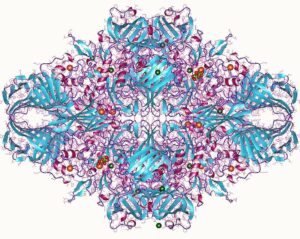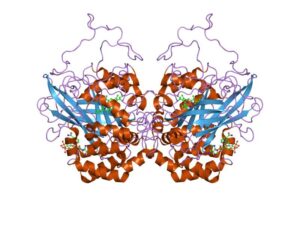Many microbes live in a soil environment that secret enzymes to break down some complex protein structures that catalyze or increase the rate of reaction to convert into simple components like amino acids.
Now take a look this bacterial enzyme example in a brief
- Protease
- Lactase
- Pectinase
- Amylase
- Catalase
- Taq Polymerase
- Cellulase
- Xylanase
- Lipase
- Collagenase
- Urease
Protease
There are different strains of bacteria including Bacillus lichen forms, Bacillus thuringiensis, Bacillus subtilus, and some other microorganisms like Staphylococcus epidermis, and Bacteroides fragilis, Propionibacterium acnes, and many more that produce protease enzyme in cell and release it outside. It helps to digest protein and break down it into amino acids.
It is the most common bacterial enzyme example.It can also use in baking, pharmaceutical, and dairy industries, many industries like soy, silk, leather, and detergent industries, and also in silver recovery processes.
Lactase
There are different strains of bacteria including Escherichia coli, Bifidobacterium spp., Lactobacillus spp., Bacillus spp., and Streptococcus thermophilus can produce this enzyme that helps to split some molecule and convert it into galactose and glucose. This enzyme is mainly used for dairy industrial purposes, for the production of lactose-free products, or some essential food products. The most common application is to help digest lactose in the condition of lactose intolerance.

Image from Wikipedia
Pectinase
Some alkalophilic bacteria in which bacillus spp., are mainly responsible for the production of pectinase enzyme. The most common fungi that are widely used for the production of pectinase for use in industrial production in Aspergillus niger.
It is the most common bacterial enzyme example. The enzyme is widely used for the extraction and clarification of fruit juice, Recycling waste paper, Extraction of vegetable oil, Textile industry, Fruit and vegetable processing, and many more. The pectinase enzyme is used in fruit industries at a very large scale for the degradation of pectin.
Amylase
Some most common strains of bacteria include Bacillus stearothermophilus, Bacillus amyloliquefaciens, and Bacillus stearothermophilus can able to produce enzyme amylase.
The bacteria Escherichia coli can also produce a type of amylase known as a cytoplasmic alpha-amylase Amy A. It is the most common bacterial enzyme example.The enzyme can use for different industrial purposes like in fermentation, paper, and textile or food industries, baking, preparation of digestive aids, brewing, and production of fruit juice and starch syrups.The enzyme has ability to convert very complex and thick like consistency of sample in to soluble and simple.
Catalase
It is the most common bacterial enzyme example.Some most common strains of bacteria include catalase-positive bacteria like Corynebacterium diphtheria, facultative anaerobes, strict aerobes, Nocardia, Listeria, and many more.
This all strain of bacteria can able to release the enzyme catalase and protect the condition towards the toxic by-product of oxygen metabolism and also help to facilitate some cellular detoxification, it can also neutralize the effect of hydrogen peroxide. The enzyme catalase also helps to reduce or degrade oxidative radicals that are harmful to cells.

Image from Wikipedia
Taq Polymerase
The most common species of bacteria that produce Taq DNA polymerase is Thermus aquatics. It is one kind of thermophilic bacteria that can tolerate or survive in very harsh or extreme temperature conditions.
The enzyme can use in different molecular biology techniques mainly DNA amplification during PCR reaction to make multiple copies of DNA. The enzyme can survive at very extreme temperature for a longer period of time that’s why such a strain of bacteria that has such an ability, can also know as an “extremophiles”.
Cellulase
Some of the well-known strains of bacteria like Cellulomonas, Bacillus spp, Clostridium, Bacillus subtilis, and E.coli can produce cellulose enzymes.
The purified form of cellulose can use for different biological processes like in pharmaceutical industries, various biotechnological, food and detergent industries, Textile, brewing, pulp and paper, agriculture as well as biofuel production in which the enzyme can able to degrade cellulose and make them in soluble form.
Xylanase
Some most common species of bacteria such as Arthrobacter, Micrococcus, Microbacterium, Staphylococcus, Cellulomonas, and Pseudoxanthomonas, can produce the enzyme xylanase.
It can able to degrade xylan which is present in the form of linear polysaccharides into xylose. It has large industrial applications for improvement in the texture of baking products like bread, also used to increase the end quality in cereal processing as well as in sugar recovery during biofuel production from agricultural residues.
Lipase
Some most common species of bacteria include Bacillus spp., Staphylococcus spp, and some other microbes include Burkholderia and Pseudomonas species are produce lipase enzymes.
It is the most common bacterial enzyme example.The most common applications of Lipases are used in detergent, pharmaceutical, dairy, and food industries, leather, cosmetic and paper industries, etc.
Collagenase
The most common bacterial name Clostridium histolyticum is the main source for the production of collagenase enzyme. Some other microbes include Streptomyces, Pseudomonas as well as Vibrio species.
Collagenase has different uses in different factors like in the health sector it can degrade damaged collagen tissue and that will help for the growth of new healthy tissue. It can also be used for some other medical purposes, Brewing industries, cosmetics as well as analytical and scientific research.
Urease
The most common species of bacteria include Mycobacterium bovis and mycobacterium tuberculosis is generally synthesized by the enzyme urease. It is one kind of pathogenic mycobacteria. Urease is an enzyme also observed in other bacterial species such as helicobacter pyroli.
The enzyme is mainly used the industrial waste water process to make them useful, various biotechnological applications as well as to remove or eliminate the toxicity of urea from clinical and environmental samples. The enzyme is also responsible for the decomposition of urea into carbon dioxide and volatile ammonia. such kind of enzyme activity is harmful to human purposes.
Conclusion
Different strains of bacteria are used to produce their useful enzymes. The enzymes can give a product at a very fast rate due to their catalytic activity which becomes helpful for various productions at the industrial level.
Also Read:
- Enzymes and photosynthesis
- Horseshoe crab characteristics
- Cytosol and cytoplasm
- Native species examples
- Millipedes examples
- Do protists have a nucleus
- Do bacteria do glycolysis
- Is chloroplast an enzyme
- Enzymes and metabolism
- Is adenine sugar

Hello, I am Bhairavi Rathod, I have completed my Master’s in Biotechnology and qualified ICAR NET 2021 in Agricultural Biotechnology. My area of specialization is Integrated Biotechnology. I have the experience to teach and write very complex things in a simple way for learners.